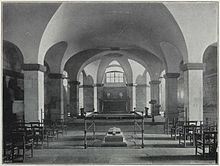Henry Hart Milman

Henry Hart Milman (10 February 1791 – 24 September 1868[1]) was an English historian and ecclesiastic.
Life
He was born in
In 1821 Milman was elected

Milman was buried in the crypt of
Works
Milman made his appearance as a dramatist with his
Turning to another field, Milman published in 1829 his History of the Jews, which is memorable as the first by an English clergyman which treated the Jews as an Oriental tribe, recognized sheikhs and amirs in the Old Testament, sifted and classified documentary evidence, and evaded or minimized the miraculous. In consequence, the author was attacked and his preferment was delayed. His History of Christianity to the Abolition of Paganism in the Roman Empire[6] (1840) had been completely ignored; but the continuation of his major work, the History of Latin Christianity[7] (1855), which has passed through many editions, was well received. In 1838 he had edited Edward Gibbon's Decline and Fall of the Roman Empire,[8] and in the following year published his Life of Gibbon.[2]
Milman was also responsible for an edition of Horace, and when he died he had almost finished a history of St Paul's Cathedral, which was completed and published by his son, A. Milman (London, 1868), who also collected and published in 1879 a volume of his essays and articles.[2]
Milman wrote the hymn, Ride On, Ride On in Majesty!, often sung on Palm Sunday.[9]
Family
By his wife, Mary Ann Cockell, a daughter of Lieut.-General William Cockell, Milman had four sons and two daughters. Among the sons were
Notes
- ^ Chisholm (1911) has it as 10 November but the son's history of the father asserts that it was 10 February.
- ^ a b c d e Chisholm 1911.
- ^ "Book of Members, 1780–2010: Chapter M" (PDF). American Academy of Arts and Sciences. Retrieved 13 September 2016.
- Sinclair, W.p. 465: London; Chapman & Hall, Ltd; 1909.
- ^ Available online at Project Gutenberg
- ^ Milman, H. Hart. (1840). The history of Christianity from the birth of Christ to the abolition of paganism in the Roman empire. New and rev. ed. London: John Murray, vol. 1; vol. 2; vol. 3
- ^ Available online at Internet Archive
- ^ Available online at Project Gutenberg
- ^ "Ride on, Ride on in Majesty!".
References
- Archibald Campbell Tait, Sermon in Memory of H. H. Milman (London, 1868)
- Arthur Milman, H. H. Milman (London, 1900)
- Memoirs of R. Milman, bishop of Calcutta, by his sister, Frances Maria Milman (1879)
- This article incorporates text from a publication now in the public domain: Chisholm, Hugh, ed. (1911). "Milman, Henry Hart". Encyclopædia Britannica. Vol. 18 (11th ed.). Cambridge University Press. p. 476.
- "H. C. G. Matthew, 'Milman, Henry Hart (1791–1868)', Oxford Dictionary of National Biography, Oxford University Press, Sept 2004; online edn, Oct 2006". doi:10.1093/ref:odnb/18778. (Subscription or UK public library membershiprequired.)
- W. M. Parker, 'Dean Milman and the Quarterly Review', Quarterly Review, 293 (1955), 30–43
- Milman, H. Hart. (1867). The history of Christianity from the birth of Christ to the abolition of paganism in the Roman empire. New and rev. ed. London: John Murray, vol. 1; vol. 2; vol. 3
External links
- Works by Henry Hart Milman at Project Gutenberg
- Works by or about Henry Hart Milman at Internet Archive
- Works by Henry Hart Milman at LibriVox (public domain audiobooks)

